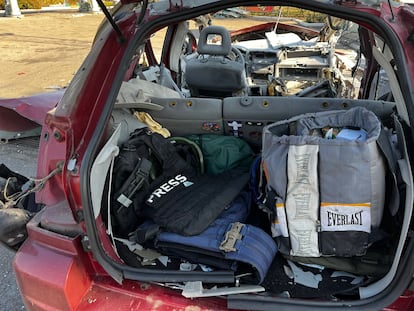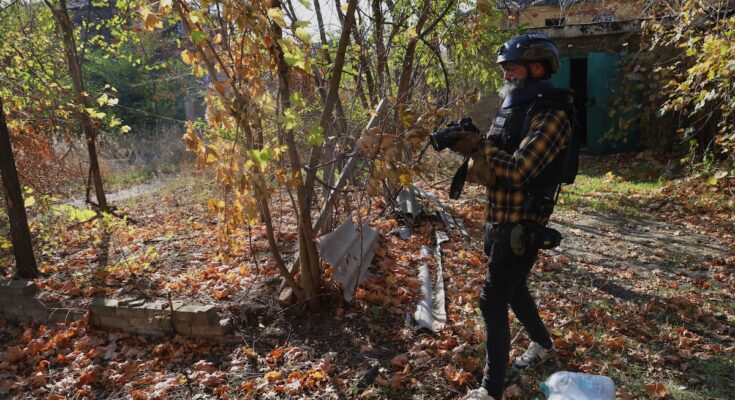The recent attack in eastern Ukraine in which Ukrainian photojournalist Oleg Petrasyuk was seen dressed in camouflage and firing not with a camera but with a rifle at a Russian drone explains well the predicament the reporting profession finds itself in in this conflict. Martial law forces citizens between the ages of 25 and 60 to enlist. Petrasyuk, who began covering the Russian invasion by taking photos for the European Pressphoto Agency (EPA), is now a press officer for the 24th Brigade. At the end of October, the young man was accompanying a Dutch reporter with other soldiers to Kostiantinivka (Donetsk region) when, in front of the door of a bombed church, a kamikaze drone began to approach them. “Go into the church,” he asked her as he tried to refine his aim with successive shots until, in the woods in the background, the bomb was seen exploding, according to the video of the events.
The number of attacks against local and foreign journalists has increased in Ukraine in recent weeks. In almost all of the latest cases, the main weapon has been drones, which have gained importance in the last four years of conflict, since Russia launched the major invasion in February 2022. In this period, 116 informants have died as a result of Russian attacks, according to the Ukrainian Ministry of Culture, which includes in the count all those converted to uniform. Those who lost their lives practicing their profession without being soldiers are 18. According to the same source, up to 27, including an army press officer, remain captured by the invading troops.
On the Russian side there have been 14 deaths, eight of which in the last year, according to the official Tass agency. All but two, who were on Russian soil near the border, did so while accompanying Kremlin troops into Ukrainian territories they maintain under occupation.
In any case, neither the Kremlin nor Kiev issued a specific threat against the journalists present. For the President of Ukraine Volodymyr Zelenskyj, however, this is not a coincidence. “These are not accidents or mistakes, but rather a deliberate Russian strategy aimed at silencing all independent voices denouncing Russian war crimes in Ukraine,” he denounced on his social networks after one of the latest incidents.
At the Committee to Protect Journalists (CPJ) “we have no confirmation that there is a strategy or orders from Moscow to specifically attack journalists”, but some cases “make us think that, in fact, journalists are a target”, since they were wearing visible press badges, comments Gulnoza Said, program coordinator for Europe and Central Asia at this institution. As for the area under the Kremlin’s control, “I am not aware of the strategy to assassinate those who cover the war for the Russian propaganda media and which Russia calls journalists OR journalists”, he adds.
In general, the special envoys consulted for this report doubt whether they have become a concrete target, although they recognize that, at this point in the war, it hardly matters whether they are military, civilian or informers. “It’s hard to say,” says Charles-Frédérick Ouellet, a Canadian documentary photographer who works regularly in Ukraine, “but I think we’re one step behind in terms of our digital footprint and we’re leaving a lot more clues.” online than we think, which makes it easier for them to track us. “AS freelancerI have always been very cautious and have to ensure my safety. However, recent tragic deaths have made me even more cautious about the places I frequent,” he says in an exchange of written messages.
The Spanish María Senovilla, a freelancer who lives in Kramatorsk (Donetsk) and did not fail to indicate on his bulletproof vest and helmet that he is a journalist, believes that the Russians “shoot indiscriminately at everything. Civilians, military, critical infrastructures…”. As an example, the attack carried out on a gas station in the same city on October 23, when a drone killed journalist Olena Gubanova, working under the pseudonym Olena Gramova, and cameraman Yevhen Karmazin, both from the Ukrainian channel Freedom. The bomb hit his car, which did not have PRESS signs, leaving Oleksandr Kolychev, who was the driver, injured. The three had worked together for five years and often went to the front.
From the hospital in Dnipro, where he is still hospitalized for serious injuries, Kolychev gives his version by telephone: “The Russians knew we were there” and “they used a lancet”, a type of “very destructive” drone that is usually used for larger targets or military vehicles, he adds. In the trunk of the vehicle, which was detonated, there were the bulletproof vests and helmets of the journalists, who were about twenty kilometers from the Russian positions. Kolichev explains that his media had no special protocol, but that they prepared their coverage by analyzing where they were traveling. The reality is that the increased use of drones has expanded the danger zone, which occupies more kilometers than three years ago.
“Now I conscientiously wear a vest for everything,” Senovilla adds in a phone conversation. Three days after that call, a Russian drone hits the perfectly identified armored van in which, together with another journalist, Senovilla accompanies two workers from the NGO Proliska to evacuate the residents of the besieged Kostiantinivka. “This was not a military vehicle nor were we near a trench,” he defends. There are no injuries, but the vehicle is seriously damaged. “I will certainly continue. The only thing this shows is that it is becoming increasingly difficult to be a journalist,” he stresses. “I won’t even tell you about the poor evacuators,” he says.

Other journalists consulted have adopted new habits on the front lines in the face of drone harassment. “I avoid stopping on the road and try to maintain a speed of around 120 kilometers per hour, which helps. I always park under trees or between buildings. I drive with the windows down and without music to hear the noise of the drones. I almost never have PRESS signs in my car,” explains André Luís Alves, journalist. freelancer Portuguese in Ukraine. Not even the Canadian Charles-Frédérick Ouellet.
On October 3, another drone killed French photojournalist Antoni Lallican, not far from Kramatorsk, and seriously injured his Ukrainian colleague George Ivanchenko, who needed to have his leg amputated. On the 13th, another Russian kamikaze bomb hit an area in the Denipropetrovsk region where a German media team Die Welt He recorded with several soldiers. One of the soldiers died, another was seriously injured and, of the three informants, local producer Ivan Zakharenko was hit in the legs by shrapnel.
“It’s yet another example of the extraordinary risks journalists face when covering Russia’s war in Ukraine amid widespread use of drones,” said CPJ’s Gulnoza Said. “Journalists are civilians according to international humanitarian law and must be able to report on war in a safe manner,” he added according to a statement published by this organization, which brings the number of reporters killed in the exercise of their profession to 21 compared to 18 by local authorities and also denounces several attacks on media offices.
“The Russians attack civilians and, in fact, the international law that protects them is the same that protects journalists,” says the Portuguese Alves. “It’s true that the Russians try to intimidate the press,” but “the Ukrainians also attack journalists linked to the Kremlin, accusing them of propaganda, which seems to me to be a mistake,” he adds.
“Continuing to work in the field is still very dangerous because we know that Russia does not respect international or Ukrainian journalists at all,” complains Alfonso Bauluz, president of Reporters Without Borders (RSF) in Spain. The current situation also coincides with the largest internal repression implemented by the Russian authorities, according to CPJ, which denounces the exile imposed on hundreds of journalists accused and tried in absentia or the persecution and criminalization of those who work in the country. The detainees amount to 27 (15 Russians, 10 Ukrainians and two Americans, of which four were released, two exiled and one murdered). Up to 23 media outlets have been banned as “undesirable” and more than 25,000 websites blocked in relation to information on the war, CPJ adds.
Despite the increase in attacks on Ukrainian territory, the figures used in this conflict have nothing to do with the at least 225 murders of informants and media workers that the Israeli army has carried out in the Gaza Strip since October 2023. The government led by Prime Minister Benjamin Netanyahu continues to veto the independent entry of journalists into that territory.
In Ukraine, the reporter’s scope for movement is much larger, although this increased drone activity complicates the transfer of soldiers to and from their positions, which also directly affects the journalists accompanying them. “No matter how much they want to work with you, no matter how much they want to bring you to the forefront, 90% of the time they can’t,” laments María Senovilla. The anti-drone network tunnel covering the road leading to Kostiantinivka is severely damaged by the permanent offensive of Russian unmanned devices. It was there that, on Monday 3 November, a Radio Liberty team was the target of an attack that several soldiers managed to repel with gunfire in an increasingly frequent scene in eastern Ukraine. In fact, in the same area, on Saturday 8th the attack took place on the van that was about to evacuate the neighbors in which María Senovilla was also travelling.


